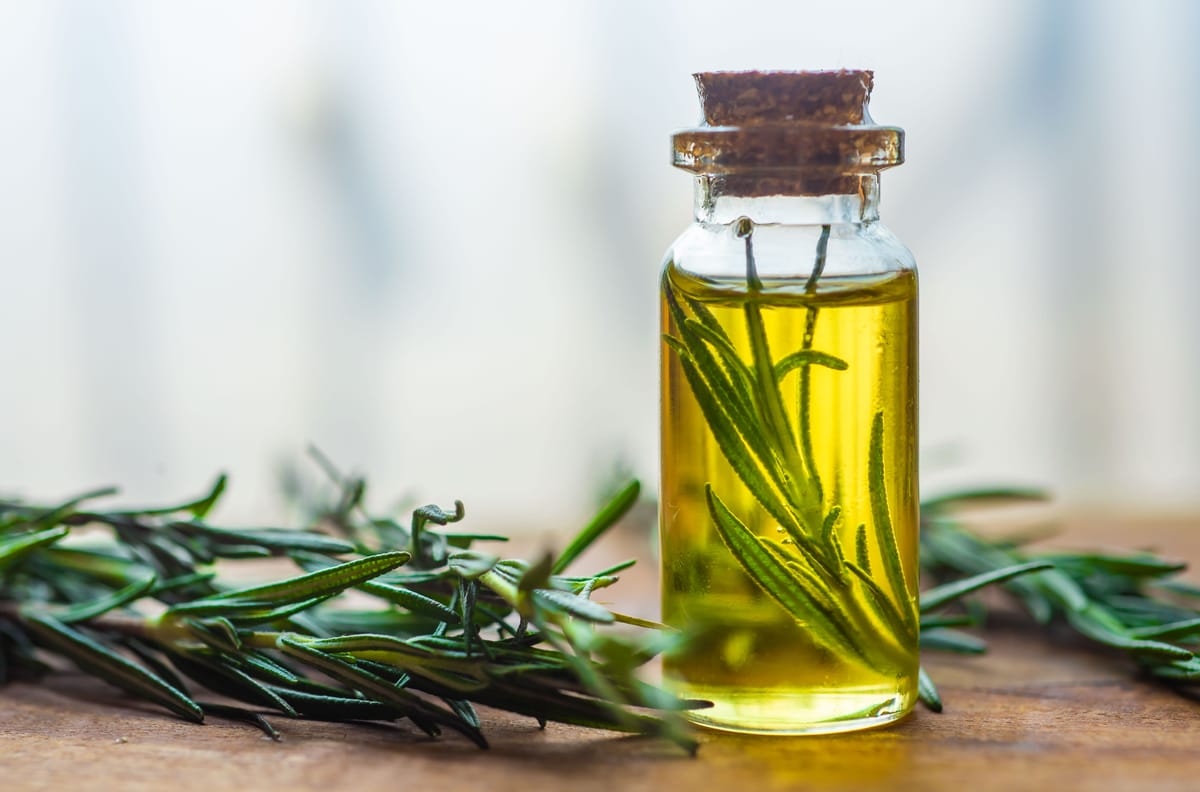How to Make Rosemary Oil: A Fragrant DIY Project
Learn how to make rosemary oil at home with our easy-to-follow guide. Discover the benefits and creative uses of this fragrant, versatile oil.

Dive into a fun DIY project and concoct your very own rosemary oil! This versatile, heavenly-scented oil will revolutionize your kitchen creations, skincare routine, and gift-giving game. The most exciting part? Crafting it is a breeze - you'll be amazed you didn't start sooner.
When I first ventured into crafting rosemary oil, I was filled with apprehension, believing it to be a complex undertaking. However, I quickly realized how mistaken I was! Armed with a few essential components and a bit of time, I soon held in my hands a vial of vibrantly green, aromatic oil that I couldn't wait to utilize. Today, I'm thrilled to invite you along on this very same adventure.
Table of Contents:
- Choosing the Right Ingredients for Rosemary Oil
- Methods for Making Rosemary-Infused Oil
- Step-by-Step Guide to Making Rosemary Oil
- Creative Uses for Homemade Rosemary Oil
- Tips for Achieving the Best Results
- Conclusion
Choosing the Right Ingredients for Rosemary Oil
When it comes to making rosemary oil, the quality of your ingredients can make or break the final product. You want an oil that's richly aromatic, with a deep green color and savory taste that captures the essence of fresh rosemary leaves.
Fresh vs Dried Rosemary
The first decision you'll need to make is whether to use fresh or dried rosemary. I've experimented with both, and while dried rosemary is certainly more convenient, I've found that fresh rosemary leaves yield a more potent and flavorful oil. If you do opt for dried rosemary, make sure it's vibrant and fragrant - old, faded herbs will result in a lackluster infusion.
Selecting Quality Olive Oil
Now, let's talk olive oil. While you might be tempted to reach for the fanciest extra virgin olive oil on the shelf, I've actually had better results with a milder, less expensive virgin olive oil. The robust flavor of extra virgin olive oil can sometimes overpower the delicate rosemary notes. A quality virgin olive oil provides a neutral base that really lets the herb shine.
Considering Other Carrier Oils
Of course, olive oil isn't your only option. Depending on how you plan to use your rosemary oil, you might consider experimenting with other carrier oils like jojoba, coconut, or almond. I love using a rosemary-infused jojoba oil for haircare, while coconut oil lends a lovely scent to homemade skincare products. Don't be afraid to get creative and find the combination that works best for you.
Methods for Making Rosemary-Infused Oil
So you've gathered your ingredients - now it's time to get infusing. There are a few different methods for making rosemary oil, each with its own pros and cons.
Stovetop Infusion
The quickest and most common method is a stovetop infusion. Simply combine your rosemary leaves and olive oil in a saucepan and gently heat over low heat for 30-60 minutes. The key here is to keep the heat very low - you want the oil to slowly infuse, not cook the rosemary. I like to use a thermometer to make sure the oil stays around 100°F.
Slow Cooker Method
If you have a bit more time, the slow cooker method is a great hands-off approach. Combine your ingredients in the slow cooker, set it to low, and let it infuse for 4-8 hours. This low and slow process really allows the flavors to develop, and you don't have to worry about monitoring the temperature as closely.
Double Boiler Technique
For a gentler infusion, you can use a double boiler setup. Place your rosemary and oil in a heat-safe bowl set over a pot of simmering water. The indirect heat gradually warms the oil, creating a subtle infusion without any risk of burning.
Cold Infusion
Finally, if you're really patient, you can try a cold infusion. Simply combine your ingredients in a jar, seal it tightly, and let it sit in a cool, dark place for 2-4 weeks. Give the jar a shake every day or so to encourage infusion. While this method takes the longest, it produces a very delicate, nuanced oil with no heat exposure.
Step-by-Step Guide to Making Rosemary Oil
Ready to give it a try? Here's a simple step-by-step guide to making your own rosemary-infused olive oil at home:
Preparing the Ingredients
Start by washing your fresh rosemary sprigs and patting them dry with a clean towel. Strip the leaves from the stems (you can save the stems for adding flavor to soups or stews). If using dried rosemary, give it a quick crush with your fingers to help release the aromatic oils.
Infusing the Oil
Place the rosemary leaves in a clean, dry glass jar and pour the olive oil over top. Use a spoon to stir and fully submerge the leaves. Seal the jar tightly with a lid. If using the stovetop or slow cooker method, proceed with infusing the oil according to the directions above. For a cold infusion, simply place the sealed jar in a cool, dark cupboard and let it infuse for 2-4 weeks, shaking occasionally.
Straining and Storing
Once your oil is finished infusing, strain out the rosemary leaves using a fine mesh sieve or cheesecloth. Discard the leaves (or compost them.). Pour the strained oil into a clean glass bottle or jar with a tight-fitting lid. Label the jar with the date and contents.
Proper Storage Conditions
To maximize the shelf life of your rosemary oil, store it in a cool, dark place away from direct sunlight and heat. A cupboard or pantry shelf works well. Properly stored, homemade rosemary oil should last for 2-3 months. Be sure to check for any signs of spoilage before using, and discard if the oil develops an off smell or flavor.
Creative Uses for Homemade Rosemary Oil
One of the best things about homemade rosemary oil is its versatility. Here are just a few of my favorite ways to use it:
Culinary Applications
Rosemary oil is a game-changer in the kitchen. Drizzle it over roasted vegetables, use it to marinate meats, or whisk it into salad dressings for an herbaceous kick. It's also fantastic for dipping crusty bread as an appetizer. Try brushing it on chicken before roasting for crispy, fragrant skin.
Skincare and Haircare Uses
The anti-inflammatory properties of rosemary make it a great addition to natural skincare routines, especially for those with sensitive skin. Mix a few drops of rosemary oil with your favorite moisturizer or use it as a gentle facial cleanser. For haircare, massage a small amount of rosemary oil into your scalp to stimulate circulation and promote healthy hair growth. You can also add a few drops to your shampoo or conditioner for an invigorating boost.
Gifting Ideas
Homemade rosemary oil makes a lovely and thoughtful gift for the foodies or natural beauty enthusiasts in your life. Package it in a pretty glass bottle with a handwritten label and a ribbon. Pair it with a crusty loaf of bread and some gourmet vinegar for a delicious housewarming or hostess gift.
Tips for Achieving the Best Results
Want to take your rosemary oil to the next level? Keep these simple tips in mind:
Ensuring Freshness
The fresher your ingredients, the better your oil will be. Use newly purchased, high-quality olive oil and the freshest rosemary you can find (bonus points if it's from your own herb garden.). If using dried rosemary, give it a sniff before using to make sure it hasn't lost its potency.
Achieving Optimal Flavor
The strength of your rosemary oil will depend on a few factors, including the ratio of rosemary to oil, the freshness of your ingredients, and the infusion method and time. Don't be afraid to experiment and find the combination that suits your taste buds. I've found that a ratio of about 1/4 cup fresh rosemary leaves to 1 cup olive oil produces a nice, balanced flavor.
Troubleshooting Common Issues
If your finished rosemary oil lacks flavor or aroma, it could be that your ingredients were past their prime, or you didn't infuse it long enough. On the flip side, an overly bitter or herbal oil likely means it was infused too long or at too high a temperature. In either case, chalk it up to a learning experience and try again with fresh ingredients and an adjusted infusion time. With a little practice and experimentation, you'll be whipping up batches of flavorful, fragrant rosemary oil like a pro. The possibilities for using it are endless - get creative and have fun.
Key Takeaway:
For a richly aromatic rosemary oil, fresh ingredients and the right infusion method are key. Fresh rosemary beats dried for potency, while virgin olive oil provides the perfect base. Experiment with carrier oils and methods like stovetop or slow cooker to find your ideal blend.
Conclusion
And there you have it, my friend. You've learned how to make your very own rosemary oil, from choosing the right ingredients to the various methods of infusion. You've discovered the creative ways to use this fragrant oil in your cooking, skincare, and even as a thoughtful gift.
You've started something incredible here, crafting with your own hands. There's a unique feeling of accomplishment that comes from creating something from nothing, don't you think?
So go ahead, experiment with different variations, and let your creativity run wild. And the next time someone compliments you on your glowing skin or the delicious meal you've prepared, you can smile and say, "Thanks, I made it myself."




